Past and Future of Nippon Subculture Jomon special ~JOMON・Art・Subculture➁~
さて、前回に引き続き、今回も北海道・北東北の縄文遺跡群が世界遺産に登録された記念の『縄文特集』です。僕が代表を務めるNPO法人jomonismが開催してきたアート展『ARTs of JOMON』(以下:AOJ)に参加していただいたアーティストとその作品を紹介することで、僕の考えるJOMONとは、アートやサブカルチャとの繋がりがどのようなものか、ということを述べていきます。
Continuing on from the last issue, I’m writing another “Jomon Special” to commemorate the registration of the Jomon Prehistoric Sites in Northern in Japan as a World Heritage Site. By introducing the artists and their works that have participated in the “ARTs of JOMON” (AOJ) art exhibition held by the NPO jomonism, of which I am the representative, I will try to explain what I think of JOMON and how it is connected to art and subculture.
今回始めに紹介するのは、堀江武史氏です。土器の修復家でもある堀江氏、実際の縄文遺物に触れて得た知見や考古学的な知識をアートというカタチでヴィジュアル化してくれるアーティストです。2014年、Spiral Gardenで行われたAOJに出展してくれた作品『もうひとつの縄の使い方:石を切る』は、一見「これのどこが縄文?」と誰しもが思うであろうコンテンポラリな見かけをした作品です。
The first artist I would like to introduce is Takeshi Horie. Mr. Horie is a pottery restorer, and also an artist who visualizes the knowledge he has gained from working with actual Jomon artifacts in the form of art. His work “Another Way to Use Rope: Cutting Stones”, which we exhibited at the AOJ held at Spiral Garden in 2014, is a contemporary looking work of art that, at first glance, you might think, “What part of this is Jomon?
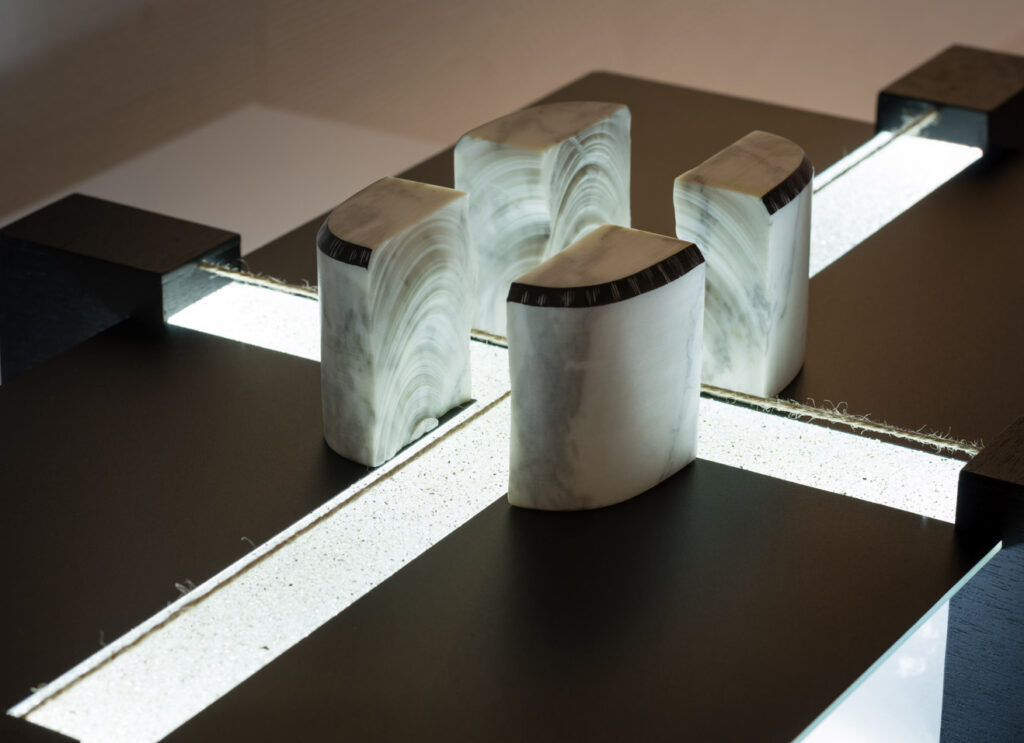
縄文時代やそれ以前の旧石器時代から“石”は人々の生活を支える重要なツールでした。木を切るための磨製石斧や石皿、そして翡翠などを用いた装飾品にいたるまで、様々な種類の石を加工するために、何千年、何万年もかけて色々な加工方法が開発されました。
麻紐を使って石を切る手法もその一つです。と偉そうに書いていますが、ぼくもこの手法は堀江氏のこの作品を通じて知りました。硬い岩石を分割する“擦り切り技法”は旧石器時代の終り頃に、シベリアから北海道に伝わり、さらに南下して新潟県糸魚川・青海地方やその周辺地域にまで伝わりました。硬くて肌理の細かい砂を研磨剤として使い、それを麻紐でこすることによって石を擦り切る技法です。(※参考①)『もうひとつの縄の使い方』では堀江氏が実際に擦り切り技法で切断した石と麻紐をライトアップした台の上に展示することによって、実際に太古に使われていた技術をアートへと昇華しています、石の切断面も美しい。コンテンポラリ・アートがコンセプトのビジュアル化だとするなら、この作品はまさに太古と現在を繋いだコンテンポラリ・アート作品と呼べます。
Stones have been an important tool to support people’s lives since the Jomon period and even before, the Paleolithic period. From polished stone axes for chopping wood, to stone plates, to ornaments made of jade, various processing methods have been developed over thousands, tens of thousands of years to process various types of stones.
One such technique is to use a hemp string to cut stones. As I write this pompously, I also learned about this technique through this work by Mr. Horie. The “abrasive cutting technique” of breaking up hard rocks was introduced from Siberia to Hokkaido at the end of the Paleolithic period, and further south to the Itoigawa and Omi regions of Niigata Prefecture and surrounding areas. It is a technique of rubbing stones by using hard and fine sand as an abrasive and rubbing it with a hemp string.(※Ref①)In “Another Way to Use a Rope”, Takeshi displays a stone and hemp cord that he actually cut with a rubbing technique on a lighted stand, sublimating a technique that was actually used in ancient times into art. The cut surface of the stone is also beautiful. If contemporary art is a visualization of a concept, then this work can be called a work of contemporary art that connects prehistoric times with the present.
もう一つ紹介する堀江氏の作品は『Ultra Sculpture』です。
The other work of Mr. Horie I would like to introduce is “Ultra Sculpture”.
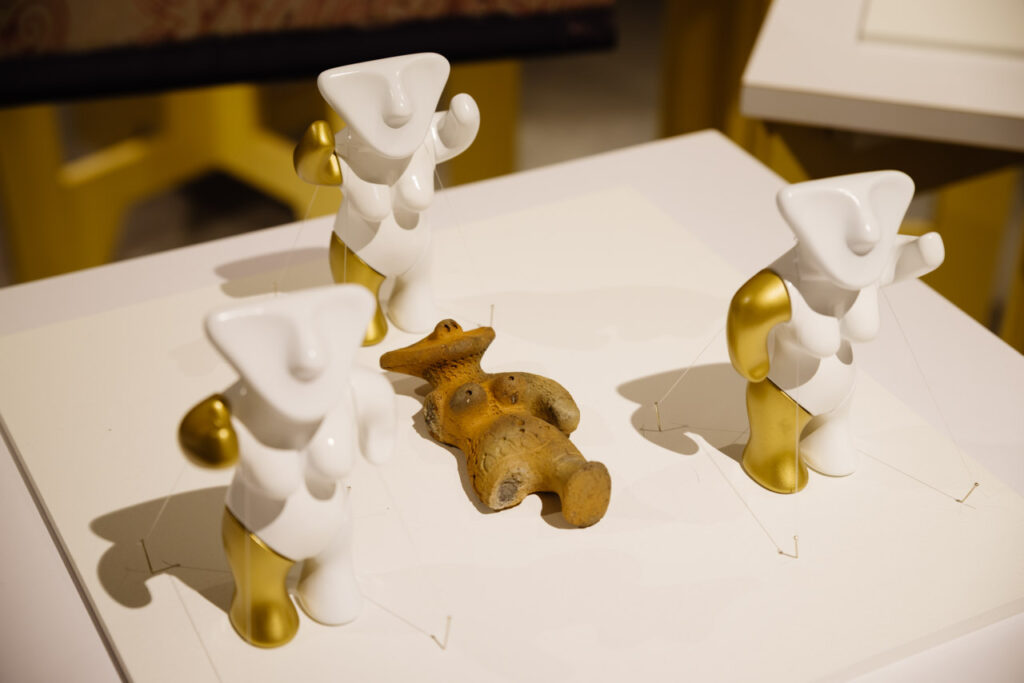
写真中央にある秋田県漆下遺跡出土の土偶(作品のものは堀江氏が制作したレプリカ)をモチーフに創られた作品なのですが、素材はPVC(ポリ塩化ビニル)、いわゆるソフビです。ソフビといえばウルトラマンや仮面ライダーのソフビを持っていたという方も多いと思いますが、現在では子供用の玩具というだけではなく様々なアーティストが作品としてソフビを制作しており、サブカルチャの一つのカテゴリ“コレクタブル・トイ”、“アート・トイ”におけるひとつのジャンルとして確立されています。
“Ultra Sculpture” was created taking motif after clay figurine excavated from the Urushita site in Akita Prefecture (the one in the work is a replica made by Mr. Horie). It is made of PVC (polyvinyl chloride), so-called sofvi. Many of you may have had sofvi of Ultraman or Kamen Rider, but nowadays, sofvi are not only toys for children, but also works of art by various artists, and have become an established genre in the subculture of “collectible toys” and “art toys”.
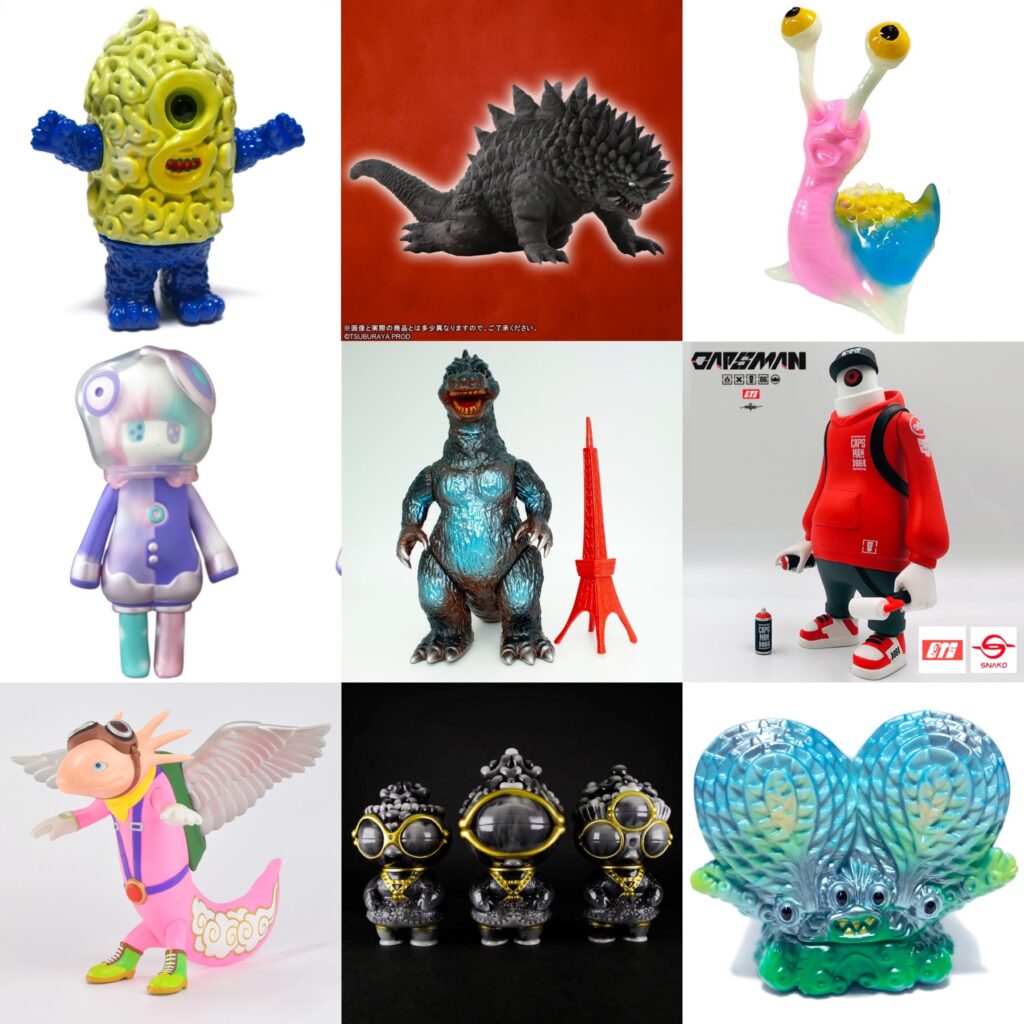
ソフビはもちろん海外でも人気なのですが、日本においてこれだけ多様なソフビがつくらている背景には縄文時代に端を発するアニミズムの精神がある、というのが僕の考えです。目には見えない精霊たち、自然の力に対する畏怖と尊敬の念をキャラクタのカタチに落とし込んだものが縄文土器や土偶であり、時代が下るとともに零落したカミや精霊たちの一部が妖怪となりサブカルチャに取り入れられていった、というストーリーは以前の記事で書いたとおりです。
堀江氏の『Ultra Sculpture』も同じようなコンセプトに基づいて創られた作品であり、縄文⇒現代日本のサブカルチャという流れを見事にヴィジュアル化しています。堀江氏の作品に共通して言えるのは、確かな考古学的知識の裏付けがあるということ、それを現代的なコンセプトとルックスに結び付けているということ、そしてどの作品も仕上げがとても丁寧ということです。
Of course, sofvi is popular overseas as well, but in my opinion, the spirit of animism that originated in the Jomon period is behind the creation of such a wide variety of sofvi in Japan. As I wrote in a previous article, Jomon earthenware and clay figurines were a way of expressing awe and respect for invisible spirits and the power of nature, and as time went on, some of the fallen kami and spirits became yokai and were incorporated into subculture.
Mr. Horie’s “Ultra Sculpture” is based on the same concept, and is a wonderful visualization of the flow from Jomon to modern Japanese subculture. What all of Horie’s works have in common is that they are backed by solid archaeological knowledge, combined with a modern concept and look, and that they are all very intricately finished.
次に紹介するのは竹谷隆之氏です。竹谷氏といえば『シン・ゴジラ』のゴジラの造形や『進撃の巨人』の超大型巨人の造形を手掛けているのでご存じの方も多いかと思います。オリジナルのアート性の強い作品から、前述のような商業作品向けのクリーチャー造形、アクションフィギュアのデザイン/原型制作まで幅広く手掛けていて、海外のファンも多いです。
Next, I would like to introduce Mr. Takayuki Takeya. Many of you may know Mr. Takeya from his work on the sculpt of Godzilla in “Shin Godzilla” and the super-sized giant in “Attack on Titan”. His work ranges from original artistic works to creature sculpting for commercial works such as the aforementioned, to action figure design/production, and he has many fans overseas.
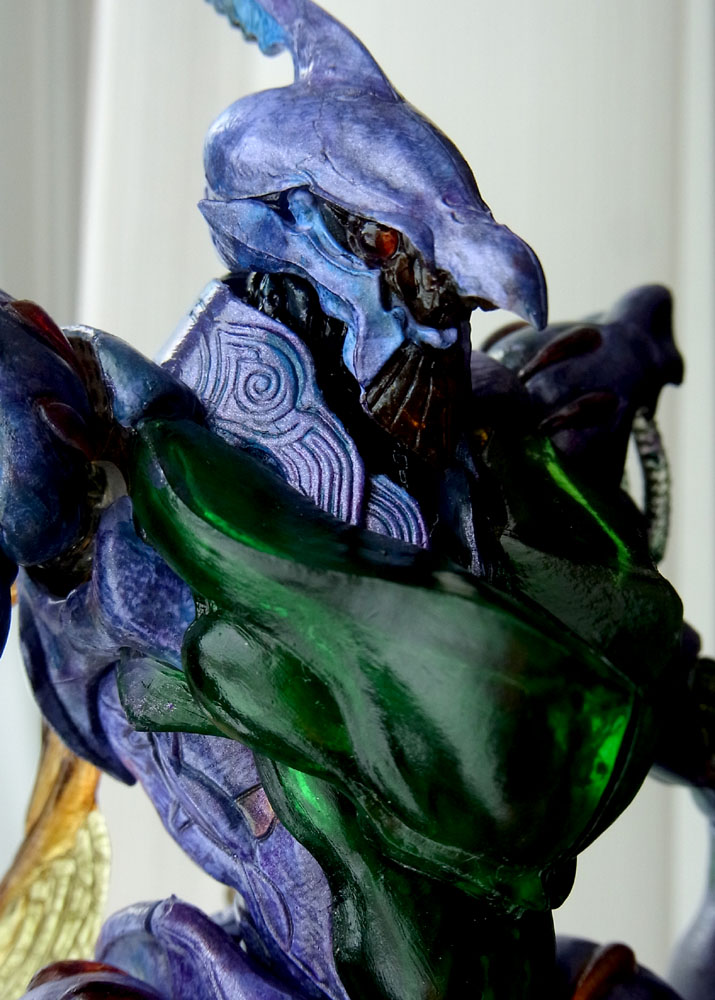
僕も、ホビー誌『S.M.H.』(※参考②)に掲載されていた作品をみて一目でファンになり、僕が作品を制作をする上でもっとも影響を受けたアーティストの一人です。以前から竹谷氏の作品に縄文的、ケルト的なディティールが溝彫りされているのが氣になっていたのですが、『ニクネカムイ』を見たときに、これは!!と思い、思い切ってAOJへの出展をお願いしました。
I became a fan at first sight when I saw his work in the hobby magazine “S.M.H.” (*Reference 2), and he is one of the artists who have influenced me the most in my work. I had always been curious about the Jomon and Celtic detailing in Mr. Takeya’s work, and when I saw “Nikunekamui”, I thought, “This is it! I was so impressed that I took the plunge and asked to exhibit at AOJ.

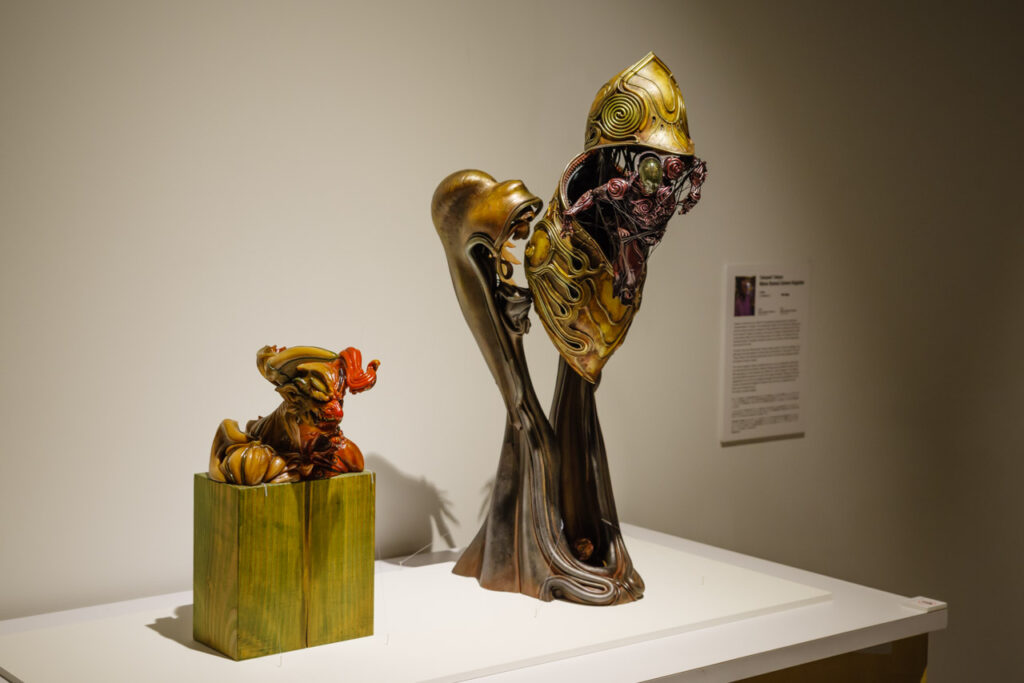
『ニクネカムイ』はアイヌ語で鬼の意(カムイ=カミ)、ただし一般的なイメージの鬼とは違いケタ違いに巨大とのことです。鬼の左半身は縄文土器をモチーフとしたうねるような角や渦巻文様が施され、逆に右半身のデザインは比較的スッキリとしており、対比として弥生(土器)をモチーフとしたということです。
ここからは僕の見解ですが、一般的に現代の日本人は縄文人と弥生人の混血であり、弥生系のDNAが70%以上を占めているといわれています。さらに一口に縄文人と言っても単一の民族ではなく、北方から来た人々、南方から来た人々等様々な人々が緩やかに混ざりあっていた、というのが僕の考えで、”日本人は単一民族”という考え方は幻想だと思っています。文化や人種は混ざればまざるほど興味深く、強靭になります。もちろんそこには軋轢も生まれますが、そういう混沌としたキメラ状態こそ人類を進歩させる原動力になると僕は信じています。
『ニクネカムイ』は造形として凄まじくカッコイイというだけではなく、縄文が現代のサブカルチャにまで影響を与え繋がっているというヴィジュアル表現であり、文化の混交をシンボライズした作品でもあると思います。
“Nikune Kamui” is the Ainu word for “oni(ogre, demon)” (Kamui=kami), but unlike the common image of an oni, this one is much more gigantic.The left half of the demon’s body is decorated with undulating horns and swirling patterns based on Jomon earthenware, while the right half of the body has a relatively clean design based on Yayoi design(histric periof after Jomon) as a contrast.
It’s just perspective, but it’s generally accepted that modern Japanese are a mixture of Jomon and Yayoi people, with more than 70% of their DNA being of the Yayoi lineage. In my opinion, the Jomon are not a single race, but rather a moderately mixed group of people from the north, south, etc. The idea that the Japanese are a single race is an illusion. The more cultures and races are mixed, the more interesting and strong they become. Of course, there will be conflicts, but I believe that such chaos and chimerism is the driving force for human progress.
“Nikunekamui” is not only an incredibly cool piece of art, but also a visual expression of the influence of the Jomon on modern subculture, and a symbolic representation of the intermingling of cultures.
最後にまた手前味噌になってしまいますが、僕がAOJで展示させていただいた作品を紹介します。まずは僕のコンテンポラリアート・プロジェクト『YAOYOROZ』の紹介から。YAOYOROZは最新の造形テクノロジーである3Dプリントを用いて製作された仏像/神像のシリーズです…、とこのプロジェクトを始めた当初、2012年頃は紹介していましたが、今や3Dプリントもすっかり浸透し、家庭でもそれなりのクオリティの3Dプリントができるようになってきました。
Last but not least, I’d like to introduce some of the works that I exhibited at AOJ. First of all, I would like to introduce my contemporary art project “YAOYOROZ”. This is a series of Buddhism, Shintoism and other deities’ statues made using the latest technology, 3D printing… I introduced it when I started this project back in 2012, but now 3D printing has become so widespread that it is possible to make 3D prints of reasonable quality at home.
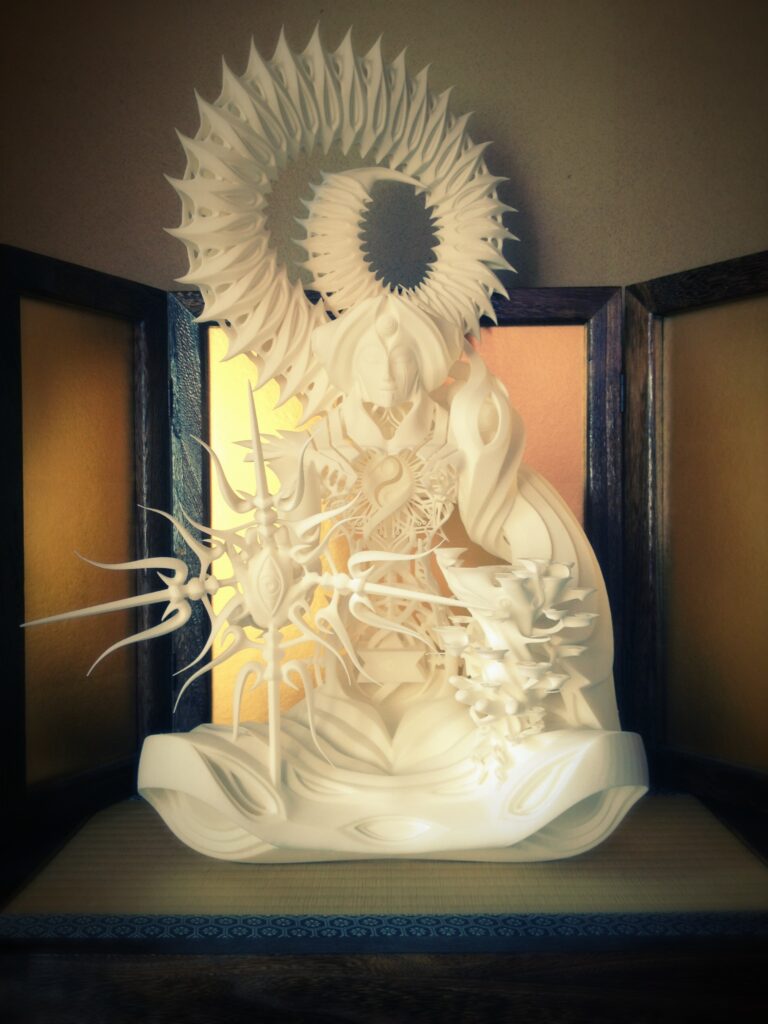
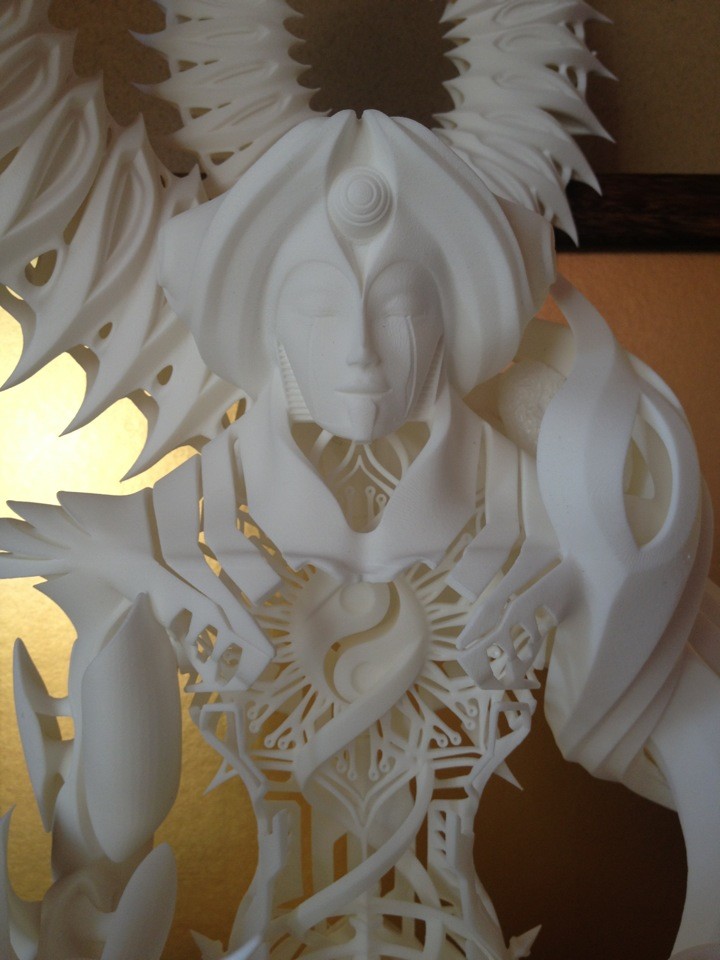
YAOYOROZ最初の作品『薬師如来』
YAOYOROZ’s first work, “Bhaisajyaguru”
ただ単に最新の技術を使用しているから”コンテンポラリ”というわけではありません。この像のシェイプには僕に影響を与えてきた日本の文化「縄文」、「仏教」そして「サブカルチャ」が全て含まれています。数多くの文化的影響は、僕というフィルターを通り、凝縮され、ひとつの像の上で曼荼羅的に展開されます。ARTs of “JOMON”なのに何故仏像なのか?と疑問に思う方もいると思います。僕の考えでは、縄文のアニミズム的な精神性は縄文時代で終わってしまったわけではありません。縄文時代以降、仏教も含めて色々な文化が大陸から伝わってきていますが、縄文の精神は新しい文化と融合し時代を下っても脈々と受け継がれてきました。仏像制作においても、特に木から仏の像を彫りだす一刀彫り等の仏像を観ると、単に仏の像を創っているというよりも、木が持つ自然の力と対話しながら、その力に抗うことなく且つニンゲンが持つ意思の力、デザインの力と融和させていく、という非常にアニミスティックな制作をしています。
It’s not just “contemporary” because it uses the latest technology. The shape of this statue contains all of the Japanese culture that has influenced me: Jomon, Buddhism, and subculture. Many cultural influences have passed through my filter, condensed, and unfolded like a mandala on a single statue. Some of you may be wondering, “Why a Buddhist statue is Jomon art?” In my opinion, the animistic spirituality of the Jomon did not end with the Jomon period. Since the Jomon period, various cultures, including Buddhism, have been introduced from the continent to Japan, but the spirit of Jomon has been fused with new cultures and passed down from generation to generation. In the creation of Buddhist statues, especially when we see itto-bori, or the carving of Buddhist statues out of wood, we see that rather than simply creating a statue of Buddha, the artist is interacting with the natural power of the wood and harmonizing it with the power of the human will and design without resisting that power. This is a very animistic work.
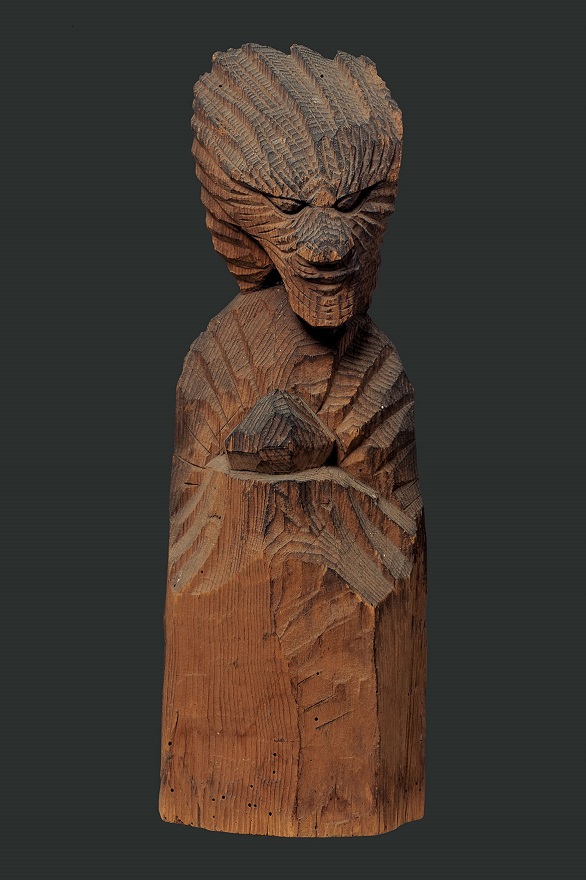
『ASURA』はそんなYAOYOROZプロジェクトの作品のひとつで、AOJ in Kuala Lumpur(マレーシア、2017)等で展示させていただきました。
”ASURA” is one of the works of the YAOYOROZ project, which was exhibited at AOJ in Kuala Lumpur (Malaysia, 2017) and other events.
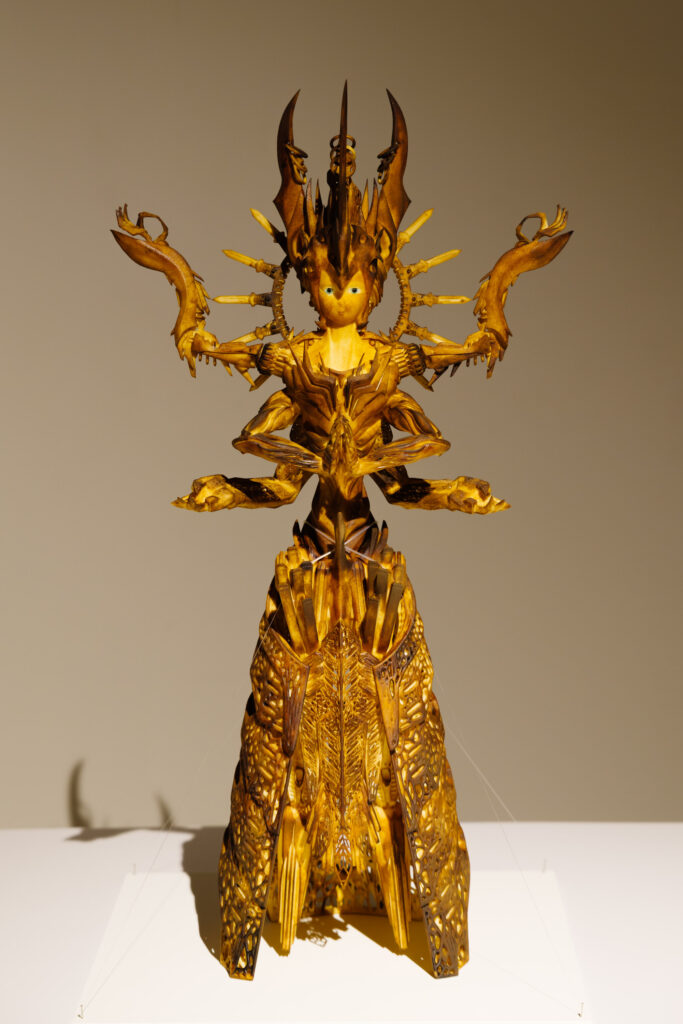
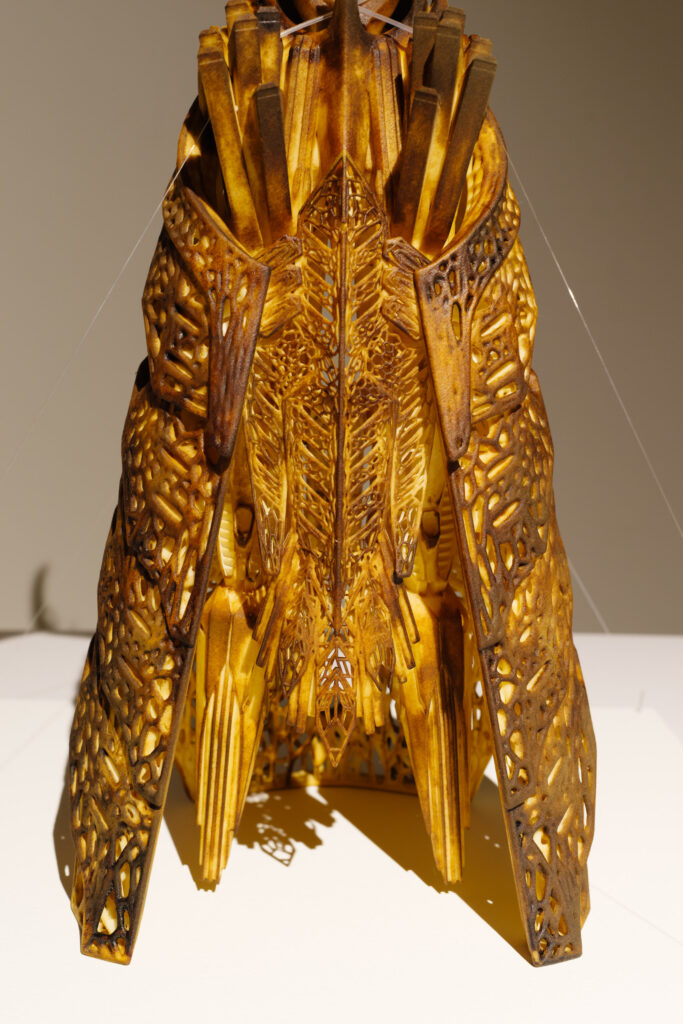
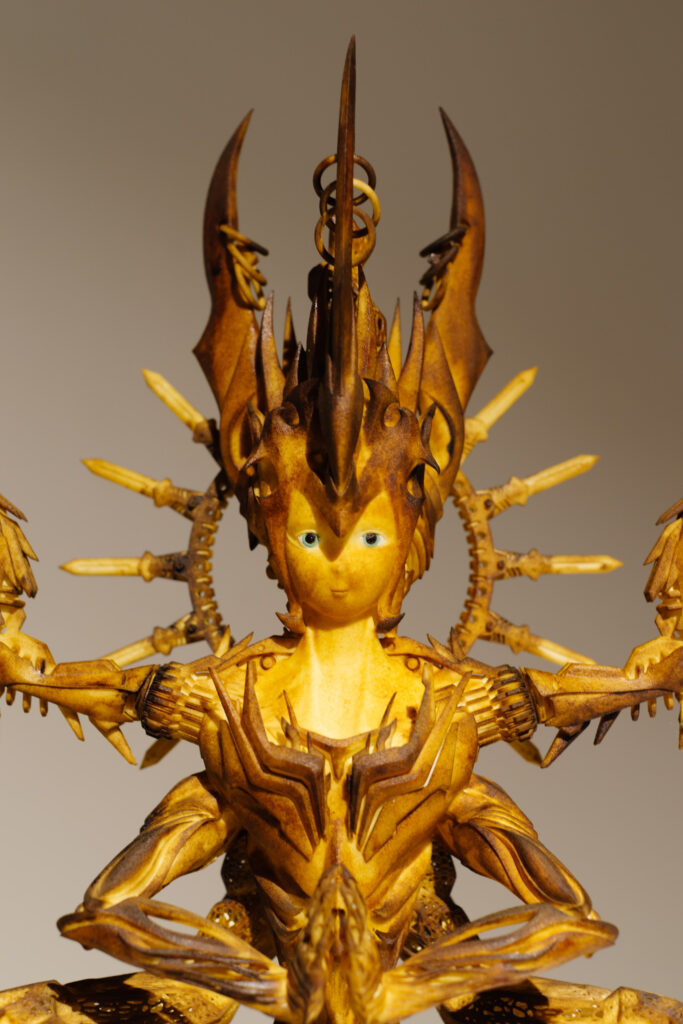
photo by Yoshiaki Hirokawa(縄と矢じり)
阿修羅をベース・モチーフにしていますが、そこにサブカル的ロボのデザインエレメントや、ジェネレイティブ・デザイン(※参考④)を使った形状を融合させています。過去と現在、人によるデザインとソフトウェアによるデザイン、といった異なる要素のバウンダリ(境界)を取り払うことにより、現在にふさわしい、そして未来へと向けた像を制作しました。3Dプリントによった生み出された形状、特に下半身の袴部分は入れ子になったメッシュ形状で、3Dプリントでなければ創り得ない形状です。
ASURAの特徴の一つである表面のフィニッシュは、漆アーティストの伊良原 満美氏にお願いし漆で仕上げいます。漆というとピカピカに磨かれた工芸品のイメージが強いですが、元々は縄文時代から使われているマテリアルで、矢じりを固定するための接着剤として使われたり、土器や土偶の表面に塗料として塗られたりしていました。ASURAの3Dプリント素材はナイロン、化学的な素材なのですが、表面を漆という自然の素材で仕上げ、異なる要素を一つに融和させることにより、木彫にも見える今までにない造形、コンテンポラリなジャパンの「サブカルチャ」「アート」「技術」を融合させた一つのマイルストーン的作品となりました。
I used Asura as the base motif, but fused it with subculture-like robot design elements and shapes using generative design (*Reference 4). By removing the boundary between different elements, such as the past and the present, design by humans and design by software, we have created a statue that is appropriate for the present and for the future.The shape created by 3D printing, especially the lower part of the hakama(pants), is a nested mesh shape that could only be created by 3D printing.
One of the unique features of ASURA is the surface finish, which is done in urushi lacquer(natural varnish made from sap ) by the urushi artist Mitsumi Irahara. Urushi is often associated with shiny, polished crafts, such as traditional bowls and dishes, but it has been used since the Jomon period, as an adhesive to fix arrowheads and as a paint on the surface of Jomon doki(earthenware) and dogu(clay figures). ASURA’s 3D printed material is nylon, a chemical material, but by finishing the surface with urushi, a natural material, and blending different elements into one, the result is an unprecedented form that looks like a wood sculpture, and a milestone work that combines contemporary Japanese “subculture,” “art,” and “technology.

さて、縄文特集ということで二回に渡りAOJに参加してくれたアーティストを紹介しながら、僕が考えるJOMONとは何かを伝えようとした試みでしたが、如何だったでしょうか?AOJには他にも素晴らしいアーティストが沢山参加してくれているので、また機会があれば紹介していきたいと思います!!
Well, that was my attempt to tell you what I think JOMON is, while introducing the artists who have participated in the AOJ over the past two issues of Jomon Special. How was it? There are many other great artists who have participated in AOJ, and I’d like to introduce them again if I have the chance!
※参考① Ref➀
「原始・古代の光技術」研磨技術について
About Polishing Technology “Primitive and Ancient Optical Technology”
※参考② Ref➁
ホビージャパンから刊行されていた雑誌。創刊1995年、2000年に休刊。安藤賢司、韮沢靖、竹谷隆之、寺田克也、山田卓司、亀井潤、鬼頭栄作、MAX渡辺、雨宮慶太、沓澤龍一郎、荒木元太郎、矢沢俊吾、芳賀一洋、岸啓介、H.Rギーガー(敬称略)等々のスパースター造形師が作品を掲載していた。フィギュア、ジオラマ、イラスト、まんが、ショートストーリー、コラム、などなど造形にかかわる幅広い内容。フィギュアといってもガレージキットや一点ものの作品が中心でよりアート寄りな内容。
A magazine that was published by Hobby Japan. First published in 1995, ceased publication in 2000. The magazine featured works by such superstar sculptors as Kenji Ando, Yasushi Nirasawa, Takayuki Takeya, Katsuya Terada, Takuji Yamada, Jun Kamei, Eisaku Kito, MAX Watanabe, Keita Amemiya, Ryuichiro Kutsuzawa, Mototaro Araki, Shungo Yazawa, Kazuhiro Haga, Keisuke Kishi, and H.R. Giger (titles omitted). There was a wide range of content related to modeling, including figures, dioramas, illustrations, manga, short stories, and columns. The figures are mainly garage kits and one-of-a-kind works, so the content is more art-oriented.
※参考③ Ref③
ニクネカムイに見る竹谷流造形術
Takeya’s Art of Modeling as seen in Nikunekamui (Only in Japanese)
http://www.takeyatakayuki.com/sphtml/zoukeiTc.html
※参考④ Ref④
ジェネレイティブデザインは、コンピュータソフトを用い、一連のシステム設計要件から、最適な設計を自律的に作成するデザイン手法。インタラクティブに指定した要件や目標(優先材料、製造プロセスなど)に基づいて、すぐに製造可能な状態の設計が、作業の開始点または最終的なソリューションとして自動的に生成される。
Generative design is a design method that uses computer software to autonomously create an optimal design from a set of system design requirements. Based on interactively specified requirements and goals (e.g., preferred materials, manufacturing processes, etc.), a design in a ready-to-manufacture state is automatically generated as a starting point or final solution for the work.
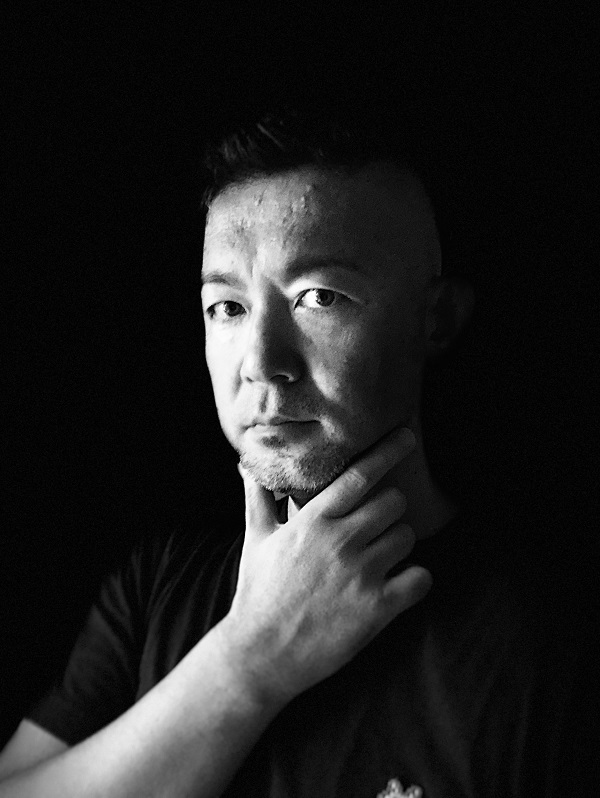
小林 武人 ポストデジタル・アーティスト
Taketo KOBAYASHI Post-digital artist
ARTSTATION
Taketo Kobayashi (artstation.com)
Instagram ID
@humanoise
NPO法人JOMONISM 代表
https://humanoise.artstation.com
慶應義塾大学 環境情報学部卒。東京工科大学クリエイティブ・ラボ、株式会社ゴンゾを経てフリーランスに。現在は“ポストデジタル・アーティスト”として、CGや3Dプリント等のデジタルツールを“筆”として使いこなし、立体作品から映像まで幅広く制作。海外でも積極的に活動しており、美術家 坂巻善徳 a.k.a. senseとのコラボレーションプロジェクト“XSENSE”では、デジタル作品をストリートアートに活かし、ミューラル(壁画)を制作(コロラド州、デンバー)。また、独自の世界観のアニメーションを舞台美術として使い、コンテンポラリー能劇団とコラボレーションで公演も行った(サンフランシスコ、デンバー)。
自身の作品制作の他に、NPO法人JOMONISMが行う”ARTs of JOMON”展のキュレーションも担当。縄文文化から影響を受けた現代美術作家を世界に紹介し続けている(青森県立美術館、スパイラルガーデン、デンバー国際空港、クアラ・ルンプール等)。
目に見えないモノ、感情、エネルギー、意識の次の次元…等をカタチにすることがミッション。
現在はシンガポール在住
After having experience of 3D graphics and animation at Tokyo Institute of Technology creative laboratory, and Gonzo Co., Ltd., Taketo started his own project as an artist. Using digital technology like CG, 3D printing as his “brush”, Taketo creates a wide variety of artworks from 3D printed sculpture to animation. In a collaboration project XSENSE, Taketo utilizes CGI in street art to create murals(Denver, CO, USA), also using his unique style animation for stage design and collaborated with contemporary Noh theatrical group. In addition to creating his own artworks, Taketo curates the group art show “ARTs of JOMON” hosted by Japanese non-profit JOMONISM, keep introducing contemporary artists/artworks influenced by ancient Japanese Jomon culture.(Aomori Museum of Art / Spiral Garden / Denver International Airport / Kuala Lumpur)
It is Taketo’s mission to make invisible things, emotions, energy, next dimensions of consciousness into “shapes”.
職歴・作品履歴(抜粋)
2004年
TVアニメーション「岩窟王」:背景デザイン、モデリング担当
2005年
スズキ「バーグマン」WEBプロモーション:バーグマン、モデリング担当
2007年
NHK アニ・クリ「火男(ヒョットコ)」:デザイン、モデリング担当
2012年
「MYSTICAL ABYSS」
アメリカ、サンフランシスコ、コンテポラリー能劇団Theatre of Yugenの公演、Mystical Abyss でオリジナルアニメーション制作、ライブプロジェクション担当
2013年-
アメリカ、デンバー、Art Across Cultures, Hope Onlineなどと共同で公演に参加。デンバーアート・ミュージアム等でアニメーションのプロジェクションを担当
2014年
2月 NPO法人JOMONISM企画「ARTs of JOMON展」@青森県立美術館、キュレーション担当
5月 シンガポール南洋工科大学3DPコンペティション参加。カンファレンス招待
11月 企業コラボーレションアート参加:オークリーストア原宿店にて作品展示
2015年
1月 NPO法人JOMONISM企画「ARTs of JOMON展」@スパイラルガーデン、キュレーション担当
2017年
“ARTs of JOMON -Hyper Subculture-” 展 キュレーション担当
伊勢丹 the ジャパンストア、クアラルンプール、マレーシア
2018年
”YouFab Exhibition – Imagination Manifests”@青年廣場 HongKong “More Than Human”プロジェクト、3Dプリント義足を展示
2019年
グループ展『童心』出展 銀座ホワイトストーン・ギャラリー
2020年
「Lights to the Night」アーティストに選出。シンガポール、アジア文明博物館にプロジェクション・マッピング
受賞歴等
オリジナルアニメーション『祭』(2010)
シーグラフ・アジア アニメーションシアター入選
YAOYOROZシリーズ『薬師如来』(2013)
3Dプリント用3DCG作品。日本図学会モデリングコンテスト、入賞
『SC1-EXP』(2014)
3Dプリント作品に映像をプロジェクション・マッピングしたインタラクティブ作品。
逗子国際プロジェクション・マッピング・フェスティバル、グランプリ
More Than Human『type-Unicorn』(2015)
3Dプリント義足。Ufab Global Creative award、ファイナリスト
“Eisen Herz”(2016)
構造計算を用いた3Dプリントミニ四駆カヴァー
Ufab Global Creative award、ファイナリスト
Project/Art history(excerpt)
PROJECTS Digital G-O-D, UltraSuperNew gallery, Singapore, Jan 2020
Haw Par Villa RE•MIX
Chinese Cultural Centre, Singapore , Jan 2020
”Light to Night Festival” Projection mapping at Asian Civilization Museum, Singapore , Jan 2020
A SIGN OF THE TIMES EXHIBITION, Singapore , Jan 2019
”ARTs of JOMON” exhibit @ISETAN KL, Malaysia , Aug 2017, curation&direction
“Colorado Crush”, a mural festival in Denver, CO. Sept 2016, created artwork
“DMS” Collaboration with Canon June 2015, created&exhibited 3D printed prosthetic leg
”Oakley Exhibition” Exhibited artworks at Oakley store Harajuku, Tokyo, Oct 2014
AWARDS “Eisen Herz” Ufab Global Creative award Finalist. 2016. 3D printed cover for “Tamiya mini 4WD” using generative design
“More Than Human type-Unicorn” a 3D printed prosthetic leg. Ufab Global Creative award Finalist. 2015
“SC1-EXP” Zushi International Projection Mapping Competition, Grand Prix. 2014
“Yakushi-Nyorai”(2013)
3DCG model for 3D printing. Winning work at Digital modeling competition held by Japan Society for Graphic Science
Original CG animation ‘Matsuri’(May 2010)
Design, modeling, production coordination. A CG animation based on Japanese ‘Jomon’ culture. Created for promotion of Aomori Prefecture. Accepted at Siggraph Asia 2010. (On VIMEO: https://vimeo.com/25144961)